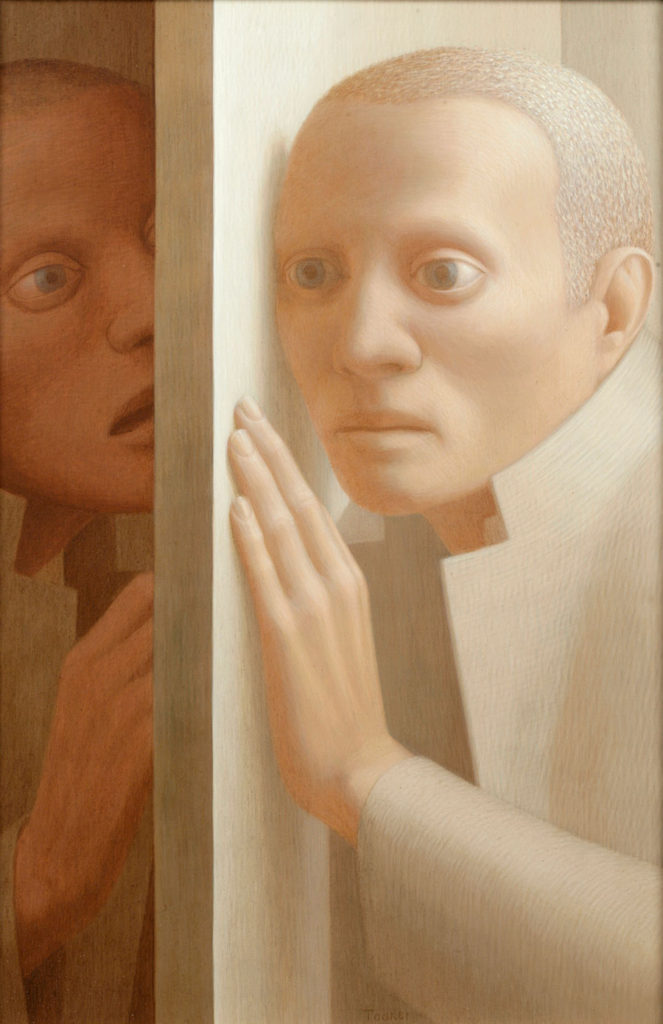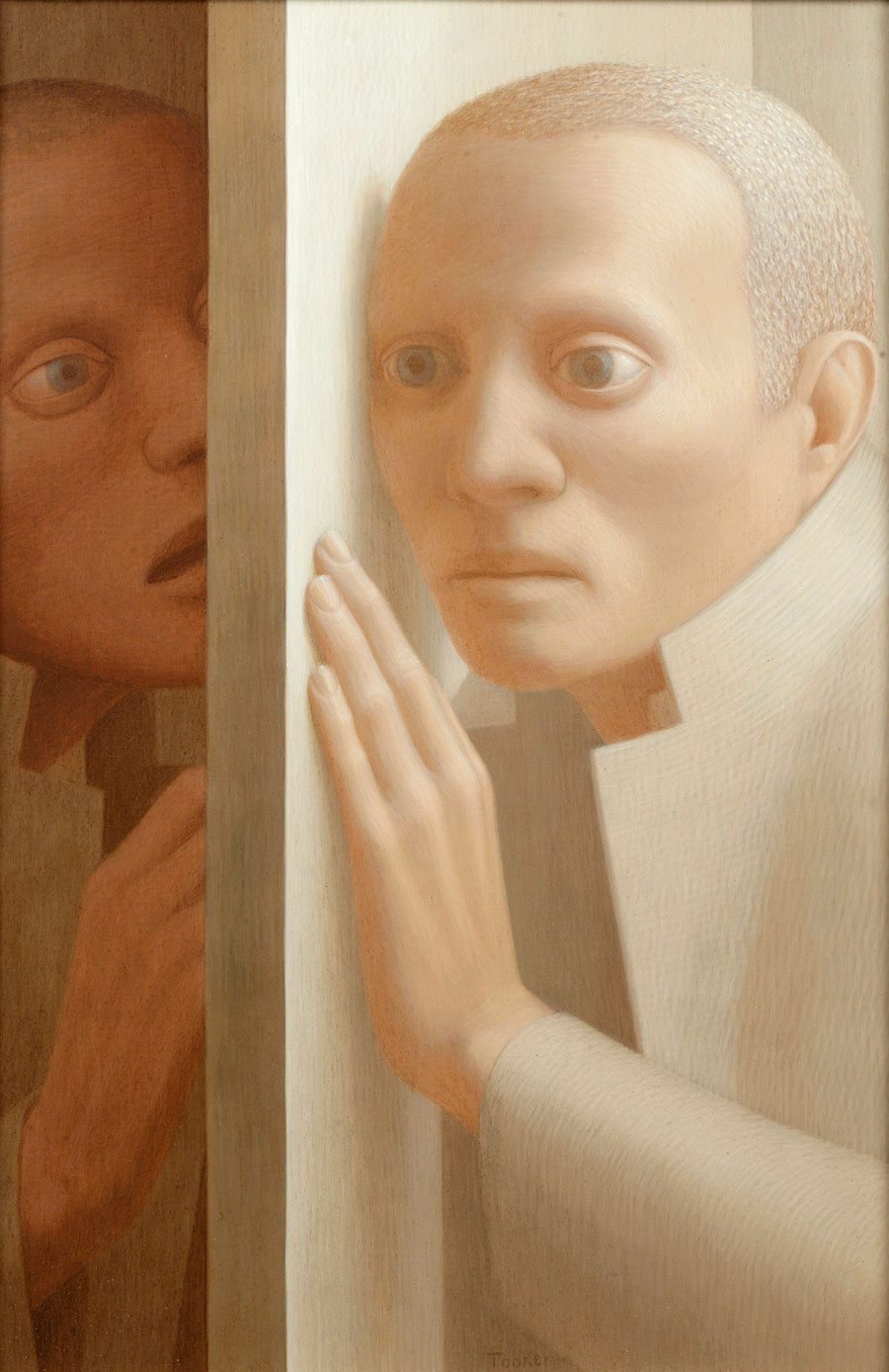“One of the unique aspects of the National Academy’s permanent collection is the ability of works and artists to speak to one another across generations, experiences, and media. Our nearly 200-year-old artist-led submission process has created an extraordinary cache of American art and architecture that tells a story of the National Academy and of American art through the eyes of its makers.
“I think, ‘What would Isabel Bishop (ANA 1940, NA 1941) say to Kenyon Cox (ANA 1900, NA 1903) about his female nudes? What would Cecilia Beaux (ANA 1894, NA 1902) say to Peter Saul (NA 2012) about his self-portrait?’ I thought it would be interesting to learn the thoughts of Academician Elizabeth King (NA 2017) on an artist and work of her choosing. When she selected Voice II by George Tooker (ANA 1968, NA 1970), I knew her words on the topic would be compelling. Not only do both Tooker and King have an innate ability to capture emotion in their figures, but the precision of their creations—Tooker with his use of egg tempera, and King with her meticulously crafted sculptures—are defining aspects of both of their practices. Their work creates distinct and uncanny worlds that seem real, but are not.”
— Diana Thompson, Director of Collections and Curatorial Affairs
Close one eye and hold up your hand to cover the speaking figure on the left. Even without it, the figure on the right is listening. How does an artist paint so invisible an action? The listening ear is hidden, but the far ear gives notice.

The two figures are held apart by a barrier wall, plank-thick, but also by the very picture plane itself, which intercepts that wall and mills its edge. All the more boxed in is the world on the figures’ side, if not ours. That implacable edge, top-to-bottom cut, almost the width of a film frame between exposures. But not quite so neutral: you hallucinate your own moving shadow on it. Then you think you see through it, conjuring the remaining ghost hand and eye of the speaker.
A painting of barriers and tight enclosures: Tooker’s hallmark, seen up close. The listening figure is pressed between frame and wall in a picture space so shallow that our own shoulder feels vicarious contact with the corner at the back. The head just touches the surface of the barrier wall, in equipoise. Likewise, the hand, but only the fingertips—so light!—not the palm or wrist. (The hand, too, is an ear.) Cast shadows and rebound light on cheek and temple report no pressure of flesh to wall. A tiny triangle of light near the chin shows the wall’s surface beneath the listening ear. Head ducked forward, eyes unfocused. It seems as if the message from the other side has only just begun.
George Tooker, voice in our ear, painter of unspoken emotion: where does the consciousness in the faces of your figures come from? First, from light, unaccountably present inside the nameless maze of walls, captured in egg tempera. Then, because egg tempera dries quickly, a painting must be built over time with countless strokes of a small brush. “Stroke, stroke, stroke,” wrote Thomas H. Garver, Tooker’s biographer, “Stroke, stroke, stroke.”1 Each stroke laid out and massed with its neighbors to feel out and find the contour of a form. Slowly, the arcs and bridges of the face, the hull of the head, emerge and lift off, built from the ground of the panel. The high-key strokes come last, and settle as light on the swells. In his articulation of volume, Tooker is like a sculptor, an architect. We peer into the open mouth on one side of the wall, the ear on the other, and we are inside the maze, then inside the heads, then in the labyrinth of the mind.
It is an urgent message. We are listening!
Voice II is on view in For America: Paintings from the National Academy of Design is presented by the National Academy of Design and the American Federation of Arts at Dayton Art Institute (February 20 – June 2, 2019), New Britain Museum of American Art (October 16, 2019 – January 26, 2020), The Society of the Four Arts (February 15 – March 13, 2020), Dixon Gallery & Gardens (July 19 – September 27, 2020), New Mexico Museum of Art (October 22, 2020 – January 17, 2021), Figge Art Museum (February 20 – May 9, 2021), Crocker Art Museum (June 6 – September 12, 2021), and the Oklahoma City Museum of Art (November 6, 2021 – January 30, 2022). The exhibition is accompanied by a richly illustrated catalogue.
Elizabeth King (NA 2017) combines figurative sculpture with stop-frame animation in works that blur the boundary between actual and virtual object. Influenced by the history of the puppet, the automaton, and literature’s host of legends in which the artificial figure comes to life, her work touches on the mind/body riddle, the anatomy of emotion, the human/machine interface, and the direct gaze in an increasingly mediated world. King’s Radical Small at MASS MoCA was on view from February 2017 through January 2018. She taught at Virginia Commonwealth University’s Department of Sculpture and Extended Media from 1985 to 2015, and is represented by Danese/Corey.
Diana Thompson is Director of Collections and Curatorial Affairs at the National Academy of Design. In addition to organizing For America: Paintings from the National Academy of Design, a major traveling exhibition of 100 works from the NAD’s collection on tour at eight US venues beginning in February, 2019, she is also currently leading a multi-year initiative to digitize the entire permanent collection for the newly-launched NA Database. This comprehensive online educational resource will include archival materials, biographies, and video documentation pertaining to the Academy’s membership, history, and artworks.
- Thomas H. Garver, “On the Art of George Tooker,” in George Tooker, Robert Cozzolino, Marshall N. Price, M. Melissa Wolfe; London and New York: Merrell, 2008, pp 14-17. Published on the occasion of the 2009 touring exhibition George Tooker: A Retrospective, on view at the National Academy Museum, the Pennsylvania Academy of Fine Arts, and Columbus Museum of Art.

